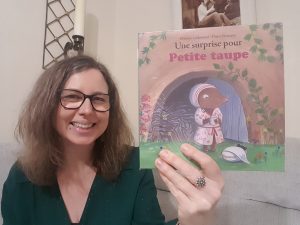
I fell in love with Petite taupe in “Petite taupe, ouvre-moi ta porte” then again in “Joyeux Noël, Petite taupe”. This is the third book in this very lovable series – click here for blogs on all of them!
Click here to look at the inside of the book and get a good idea what it is about in a very short video on my YouTube channel! Do please subscribe if you like it!
Language of text: French
Type of text: picture book
Author or source: Orianne Lallemand, Claire Frossard, published by Auzou
Intended age of students: Key Stage 2/3
Source reference: 9782733839195
This is the story of the day Petite taupe finds a baby panda outside its door… but does not know what animal it is so goes on a search for its mother. I love the twist at the end!
I ask the children what the story might be about from looking at the cover. Then I tell them that Petite taupe will knock on some doors, and that when she does they will have to join in and say “totc, toc, toc”!
For the second reading, I agree on an action for the children to do every time they hear the word “bébé”; or you could do the action and let them join in by saying the word.
After the second reading, I teach the names in French of the animals in the story (there are only 6 of them, which is a good number for a lesson). You can do this by using the book and the pictures; I am very lucky, I have hand puppets for all of them! Once they feel confident with the French words, you can read the story again but pause when the name of an animal comes up… and the children have to fill the gaps in French!
Rationale:
The children can easily join in with this story, even though the language in it is more advanced than in the orignal book “Petite taupe ouvre-moi ta porte”.
I think it is a lovely story to use when talking about birthdays or around Mothers’ Day as it celebrates mothers – and fathers too!
Outcomes:
The children will enjoy being able to understand and join in with a story that is popular in France and that children their own age may read in class over there. This will make them feel confident about their ability. It can, if you feel it is appropriate with your children, lead to a discussion about mothers, mother figures, mothers without children, children without mothers…
Topics or themes:
birthday; Mothers’ Day
Grammar:
verbs in the present tense, especially -er verbs as there are many of them used throughout the story
How much time required:
1 lesson
You can buy this book here at Amazon.co.uk.
Looking for an activity or a different story for Mothers’ Day? Look no further than by clicking here!
What is YOUR favourite story for Mothers’ Day? Please share it in the comments! Merci!
N.B. Would you like to read about books, ideas, resources and opportunities for the primary languages classroom? Then click here to receive a monthly round up of my blog (and more!) straight in your mail box!

